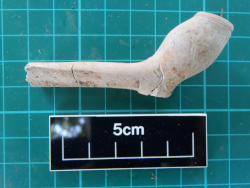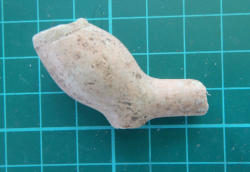13 Jul 2018
Forty Hall Summer Dig - Day 3
We had another great day's digging in Forty Hall today, despite the return of the very hot weather which made the going tough this afternoon, especially in trench one which doesn't have the benefit of shade from the avenue's lime trees.
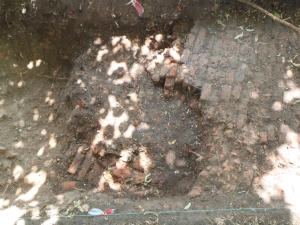
Our diggers soldiered on though, and in trench two we've finished revealing all of the hardy brick floor which served the palace building we're investigating (probably either the scullery or 'boiling house'). As we found last year, the floor is heavily worn in places and has been truncated along its eastern edge by an aggressive demolition cut.
One of our main questions to answer about this part of the Tudor kitchens' service range is how far the building extended along side the 'long barn' we uncovered earlier in the year. The demolition cut that truncated the floor is very wide, and we think it may have been made to remove the building's east end wall, leaving no trace of it behind. Fortunately for us, though, the cut does give us a chance to see the layers under the floor, and today we saw the first signs of an earlier brick floor beneath the first -- something that we saw last year, and which illustrates how this part of the palace saw considerable foot traffic -- causing the lower floor so much wear and tear that the Tudor builders laid a complete new floor surface on top of the old.
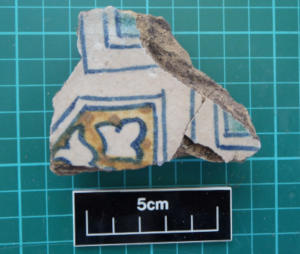
Unlike last year, however, at this point the two floor phases have a layer of coarse rubble covered with a mixture of brickearth, mortar and sand separating them, in an apparent effort to raise the newer brick floor to a higher level -- whether this is because the old floor was uneven, or perhaps stepped down at some point (perhaps between two rooms), we don't know yet. At some point over the weekend or next week we may extend the trench to see more of the floors to answer this. Tomorrow we'll probably focus on exposing and recording more of the older brick floor.
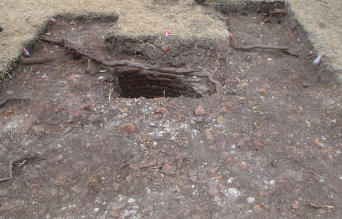
Meanwhile in trench one, we got on with deturfing the large area surrounding our water-heating furnace (pictured right) and have now revealed the ubiquitous layer of demolition rubble which covers the site.
Amongst this we found a reminder that not all of the rooms of the palace had dull brick floors -- a fragment of a hand painted Delftware floor tile (pictured above right) which would undoubtedly have come from a slightly higher status room, but perhaps nearby, and as with the other Delftware finds (see yesterday), dating to the middle of the seventeenth century; right at the end of the palace's occupation (by the Earl of Pembroke).
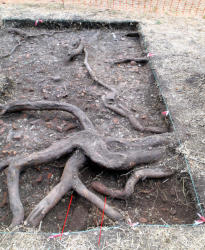
There are some tentative signs of structures beginning to emerge in trench one, although at the moment they are hard to distinguish in the sea of rubble.
Just to the west of the re-excavated furnace there looks to be the top of a wall emerging, which may be connecting the furnace to the southern perimeter wall of the building, although there's no definite sign of that yet.
At the east end of the trench, and beneath a mass of lime tree roots, we have uncovered part of the thin partition wall we saw last year, which divides the furnace room with its crude brick floors from the room to the west which contained the two garderobe chutes we saw in 2014/15 together with the remains of a probably chequered glazed tile floor (we think maybe an office for a clerk of the kitchens). The roots will make exposing more of this very difficult.
Again we had lots of great finds today; plenty of pottery and lots of very large butchered animal bones including some very large beef joints.
Yesterday we found quite a few pieces of tobacco pipe stem -- a relative rarity at Elsyng since the advent of smoking came more towards the end of the Palace's occupation -- and today we finally found two complete pipe bowls both probably dating from the early to mid-seventeenth century, perhaps even having been smoked by the very labourers who were demolishing the palace.
The weekend weather looks set to be sunny -- good for public visitors but not so great for digging. Hopefully we'll be able to keep our furnace cool enough to uncover more of its secrets!
